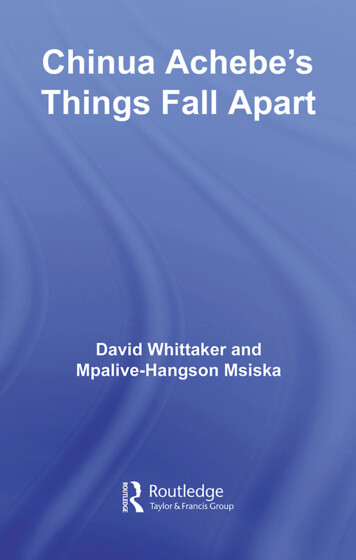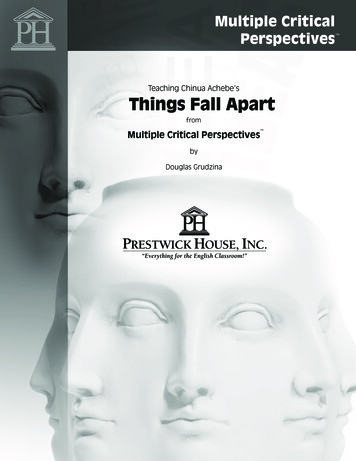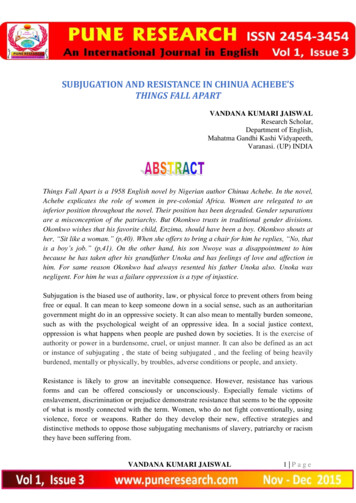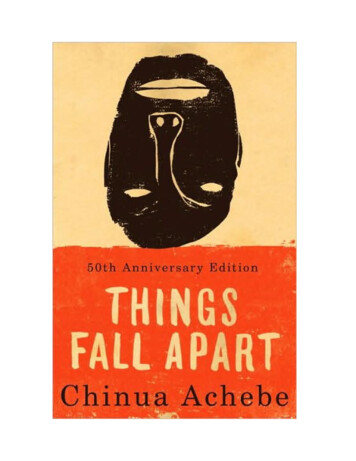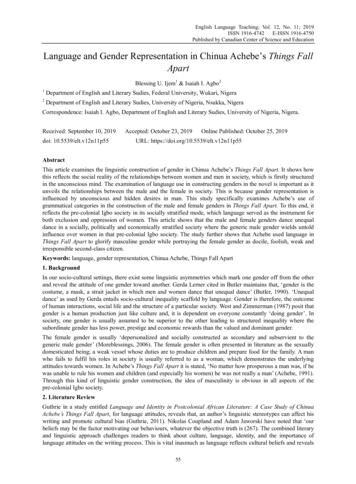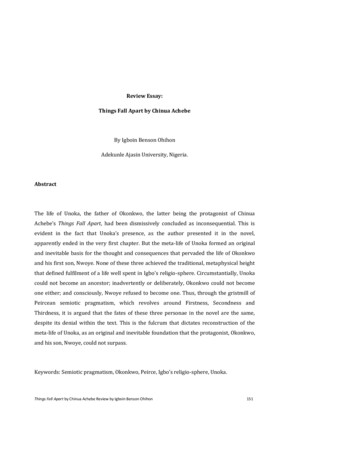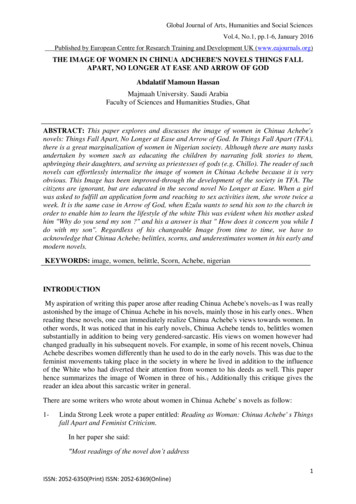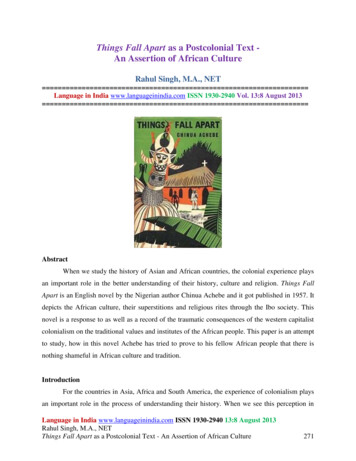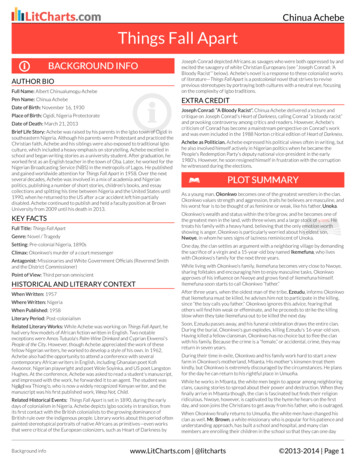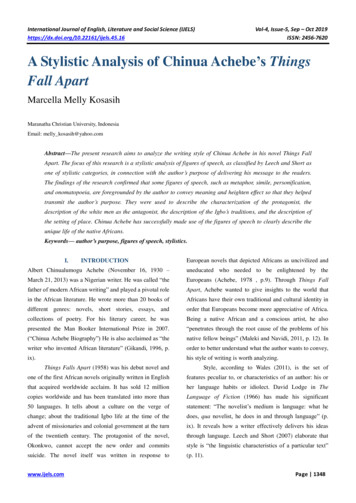
Transcription
International Journal of English, Literature and Social Science 4, Issue-5, Sep – Oct 2019ISSN: 2456-7620A Stylistic Analysis of Chinua Achebe’s ThingsFall ApartMarcella Melly KosasihMaranatha Christian University, IndonesiaEmail: melly kosasih@yahoo.comAbstract—The present research aims to analyze the writing style of Chinua Achebe in his novel Things FallApart. The focus of this research is a stylistic analysis of figures of speech, as classified by Leech and Short asone of stylistic categories, in connection with the author’s purpose of delivering his message to the readers.The findings of the research confirmed that some figures of speech, such as metaphor, simile, personification,and onomatopoeia, are foregrounded by the author to convey meaning and heighten effect so that they helpedtransmit the author’s purpose. They were used to describe the characterization of the protagonist, thedescription of the white men as the antagonist, the description of the Igbo’s traditions, and the description ofthe setting of place. Chinua Achebe has successfully made use of the figures of speech to clearly describe theunique life of the native Africans.Keywords— author’s purpose, figures of speech, stylistics.I.INTRODUCTIONEuropean novels that depicted Africans as uncivilized andAlbert Chinualumogu Achebe (November 16, 1930 –uneducated who needed to be enlightened by theMarch 21, 2013) was a Nigerian writer. He was called “theEuropeans (Achebe, 1978 , p.9). Through Things Fallfather of modern African writing” and played a pivotal roleApart, Achebe wanted to give insights to the world thatin the African literature. He wrote more than 20 books ofAfricans have their own traditional and cultural identity indifferent genres: novels, short stories, essays, andorder that Europeans become more appreciative of Africa.collections of poetry. For his literary career, he wasBeing a native African and a conscious artist, he alsopresented the Man Booker International Prize in 2007.“penetrates through the root cause of the problems of his(“Chinua Achebe Biography”) He is also acclaimed as “thenative fellow beings” (Maleki and Navidi, 2011, p. 12). Inwriter who invented African literature” (Gikandi, 1996, p.order to better understand what the author wants to convey,ix).his style of writing is worth analyzing.Things Falls Apart (1958) was his debut novel andStyle, according to Wales (2011), is the set ofone of the first African novels originally written in Englishfeatures peculiar to, or characteristics of an author: his orthat acquired worldwide acclaim. It has sold 12 millionher language habits or idiolect. David Lodge in Thecopies worldwide and has been translated into more thanLanguage of Fiction (1966) has made his significant50 languages. It tells about a culture on the verge ofstatement: “The novelist’s medium is language: what hechange; about the traditional Igbo life at the time of thedoes, qua novelist, he does in and through language” (p.advent of missionaries and colonial government at the turnix). It reveals how a writer effectively delivers his ideasof the twentieth century. The protagonist of the novel,through language. Leech and Short (2007) elaborate thatOkonkwo, cannot accept the new order and commitsstyle is “the linguistic characteristics of a particular text”suicide. The novel itself was written in response to(p. 11).www.ijels.comPage 1348
International Journal of English, Literature and Social Science 4, Issue-5, Sep – Oct 2019ISSN: 2456-7620There have been many researches and reviews byII.LITERATURE REVIEWcritics and readers of Things Fall Apart. However, most ofCacciari and Glucksberg (2007) stated that “figurativethe researches focused on post colonialism and few oflanguage is no longer perceived as merely an ornamentthem were done on the linguistic features and literaryadded to everyday, straightforward literal language, butdevices, that is, the stylistic features. Jweid (2016), forinstead viewed as a powerful communicative andexample, focused on deteriorating national identity of theconceptual tool” (p. 448). They can serve as a medium toNigerian society. The life of the protagonist was examinedbridge communication and to deliver concepts. Leech andthrough postcolonial concepts, namely aboriginality,Short (2007) considered figures of speechhegemony, subaltern and identity (p. 531). The death of theincidence of features which are foregrounded by virtue ofprotagonist due to his committing suicide reflected the falldepartingof the Nigerian indigenous identity.communication by means of language code” (p. 63). Theyinsomewayfromgeneral“thenormsofSalami and Tabari (2018) also discussed the novelstated that traditional figures of speech (schemes andfrom post-colonial discourse by using some theories fromtropes) are often useful for identifying such features asHomi Bhabha and Michael Bakhtin. The research comes to“exploitation of regularities of formal patterning, or ofthe conclusion that “Things Fall Apart can be taken as adeviations from the linguistic code” (p.63). Figure ofpostcolonial discourse drawing on the pre-colonial as wellspeech is simply defined as “a form of expression used toas the colonial Nigerian on an objective manner in order toconvey meaning by comparing or identifying one thinghelp the Nigerian readers find how to piece together whatwith another that has a meaning or connotation familiar toonce fall apart” wingThe present research tries to analyze Things Falldefinitions and examples are taken from an article writtenApart by means of literary stylistics. Stylistics, accordingby Wheeler (2018). Figures of speech are divided into twoto Verdonk (2002), is defined as “the analysis of distinctivetypes:expression in language and the description of its purpose1. Tropes: Figures of speech with an unexpected twist inand effect” (p.4). Widdowson (1975) defines stylistics asthe meaning of words. Some figures of speech which“the study of literary discourse from a linguisticare included in tropes are:orientation” (p.4). It is the link between literary criticism(a) Metaphor: When something is something else.and linguistics. According to Leech and Short (2007),- The office is a bee-hive of activity on Mondays.stylistics is simply defined as the (linguistic) study of style- This is your brain on drugs.and it has the goal of explaining “how language serves aparticular artistic function” (p.11).This research will deal with the stylistic analysis ofChinua Achebe’s novel entitled Things Fall Apart. The(b) Simile: When something is like something else.- Her skin was like alabaster.- He was as unpleasant as a wart.(c) Synecdoche: Using a part of a physical object toresearcher would like to find out how the linguisticrepresent the whole object.features, in this case the figures of speech, used by the- Twenty eyes watched our every move.writer in the novel perform their artistic function to help- All hands on deck!delivering the writer’s message. In order to understand andappreciate the artistic function better, this research willanswer the following questions:1. Which figures of speech are used by Chinua Achebe inhis novel Things Fall Apart?2. How do these figures of speech help transmitting thewriter’s message?www.ijels.com(d) Personification: Giving human qualities toinanimate objects-The ground thirsts for rain; the wind whisperedsecrets to us.(e) Onomatopoeia: Words that sound like what theymean.- buzz, rattle, click, clatter, crackle, and pop.Page 1349
International Journal of English, Literature and Social Science 4, Issue-5, Sep – Oct 2019ISSN: 2456-7620(f) Hyperbole: Exaggeration.IV.DISCUSSION- His thundering shout could split the rocks.The stylistic analysis will focus on the figures of speech2. Schemes: Figures of speech that deal with word order,used in the novel in connection with their roles to serve thesyntax, letters, and sounds. Some figures of speechauthor’s purpose. The story itself is narrated in a thirdwhich are included in schemes are:person omniscient point of view. The narrator is the focal(a) Parallelism: When the writer establishes similarcharacter who provides the reader with much informationpatterns of grammatical structure and length.about what happens in the story. In narrating the story,- King Alfred tried to make the law clear, precise,and equitable.several figures of speech are used, such as simile,metaphor, personification, onomatopoeia, and parallelism.- Her purpose was to impress the ignorant, toThey are used to describe almost all the characters andperplex the dubious, and to startle the complacent.(b) Anaphora: repetition of beginning clauseevents but the researcher will only choose those whichplay a great role in the characterization of the protagonist,- “We shall not flag or fail. We shall not go on tothe description of the white men, the description of thethe end. We shall fight in France, we shall fight onsetting of place, and the description of the Igbo traditions.the seas and oceans . . .,” declared Churchill.These things are in accordance with the purpose of the(c) Diacope: uninterrupted repetition or repetition withonly one or two words between each repeatedphrase.author, Chinua Achebe, in writing the novel.4.1. Characterization of OkonkwoOkonkwo is the protagonist of the novel. In the- “Oh, horror, horror, horror!”beginning, he is portrayed as a great warrior of theUmuofia clan, a lower Nigerian tribe, but in the end he tofhisThis research is qualitative descriptive. According tocharacteristics, the author, through the narration of theSandelowski (2000), “Qualitative descriptive study is thenarrator, uses simile, metaphor, and hyperbole.method of choice when straight descriptions of interpreting the data collected, which were in the form ofwords rather than numbers (Bogdan and Biklen, 1997,p.10). Concerning the instrument of the study, purposefulAt the age of 18, Okonkwo has brought honor to hisvillage by defeating Amalinze Cat, the great wrestler whofor seven years is undefeated, from Umuofia to Mbaino.(1) Okonkwo was as slippery as a fish in water.(Achebe, 1995, p.1)sampling technique was used to obtain cases deemed rich(2) . . . he was a fierce fighter. (p.10)in information for the purposes of completing the dataThe words used as a comparison to Okonkwo’s(Sandelowski, 2000). The researcher has chosen Chinuacharacter are effective. In wrestling, to win the game, oneAchebe’s novel Things Fall Apart, which deals with nativehas to be difficult to hold and he fights fiercely; andNigerian protagonist’s experience of coping with newOkonkwo has these characteristics to be the winner. Sinceculture and order brought by European missionaries. Datathen, Okonkwo is famous all over the area for years,collection was focused on discovering the nature of thespecific events related to the research problems. Thus,while reading the novel she focused on the foregroundedfigures of speech used in the novel. The theories of(3) Okonkwo was the great wrestler andwarrior alive. (p.50)(4) . . . whose fame had grown like a bush-fire inthe harmattan. (p.1)figurative language were used to make sure that the data(5) They treated Okonkwo like a king. (p.11)were valid and relevant. The writing style of ChinuaFrom the simile and metaphor used, it is clear thatAchebe in his Things Fall Apart was then identified basedOkonkwo is described positively. The nouns used ason the results of the analysis.comparison, a fighter, a wrestler, a warrior, and even awww.ijels.comPage 1350
International Journal of English, Literature and Social Science 4, Issue-5, Sep – Oct 2019ISSN: 2456-7620king, give an impression that Okonkwo is manly, famous,for seven years in order to make amends due to his killingand respected.a clansman. Killing a clansman is a serious crime againstAnother proof that Okonkwo considers strengthimportant in a man can be seen when he talks aboutNwoye, his eldest son.the earth goddess. He has to start from the beginning, andwork very hard to plant a new farm.(9) It was like beginning life anew without the(6) I am worried about Nwoye. A bowl ofvigor and enthusiasm of youth, like learning topounded-yams can throw him in a wrestlingmatch. His two younger brothers are morepromising. (p.27)become left-handed in old age. (p.53)The words used in the simile give a clearer pictureof what is explained, that life is very hard for Okonkwo.Here hyperbole is used to describe that Nwoye is so weakBeginning a new life and learning to become left-handedthat a bowl of pounded yams can throw him in a wrestlingin old age are not easy things to do. Besides,match, not necessarily his opponent. Exaggeration is used(10) Okonkwo’s return to his native land was notto give dramatic effect. Okonkwo’s comment on Nwoye’sas memorable as he had wished. (p.73)being a weak child implies that he actually wants a braveUmuofia does not appear to have taken any special noticeboy to be his son.of the warrior’s return as the thoughts of the people isSimile is also used when Okonkwo feels guiltyoccupied by the missionaries – their church, government,about killing Ikemefuna, which he actually ought to do toand trading stores. On returning to Umuofia, Okonkwoavoid being thought weak.finds out that the white missionaries have gained a lot ofHe does not eat anything fortwo days and just drinks palm-wine.ground.(7) He drank palm-wine from morning till night,(11) He mourned for the clan, which he sawand his eyes were red and fierce like the eyes ofbreaking up and falling apart and he mourneda rat when it was caught by the tail andfor the warlike men of Umuofia, who had sodashed against the floor. (p.25)unaccountably become soft like women.(8) Once he got up from bed and walked about his(p.74)compound. But he was so weak that his legsFrom the simile, the reader can conclude that Okonkwo iscould hardly carry him. He felt like a drunkenupset with their fellow clansmen who become weak ingiant walking with the limbs of a mosquito.dealing with the coming of the new religion to their village(pp.25-26)and breaking them up.The author describes the condition of Okonkwo byAnother simile and metaphor are used whenusing familiar animals such as a rat and a mosquito as theOkonkwo is enraged and greatly troubled by his sonobjects of comparison. Being given the explanation of theNwoye’s betrayal of becoming a Christian.rat’s eyes, the readers can easily grasp the idea of how red(12) To abandon the gods of one’s father and goand fierce Okonkwo’s eyes are (data 7). And in data (8),about with a lot of effeminate men cluckingthe readers can directly understand how Okonkwo feels atlike old hens was the very depth ofthat time. Although he is compared to a drunken giant, thatabomination. Suppose when he died all hisis believed to be strong, his limbs are compared to themale children decided to follow Nwoye’slimbs of a mosquito that cannot support the body of a giant.steps and abandon their ancestors? OkonkwoSo, the figure of speech helps the readers in knowingfelt a cold shudder run through him at theclearly the condition Okonkwo is in. His guilty feeling hasterrible prospect, like the prospect ofcaused him to be drunk and too weak to walk.annihilation. (63)Simile is also used when Okonkwo comes back toThe simile shows that Okonkwo considers Nwoye’sUmuofia after being exiled to his mother’s village, Mbantanew religion weak and effeminate, characteristics that arewww.ijels.comPage 1351
International Journal of English, Literature and Social Science 4, Issue-5, Sep – Oct 2019ISSN: 2456-7620opposite to his. For Okonkwo, manliness is very important.man’s friends . . . It said that other white menThrough the metaphor, it is shown that Nwoye’swere on their way. They were locusts, it said,abandoning the gods of his father and joining the weakand that first man was their harbinger sent toChristians are disgusting. Moreover, the personificationexplore the terrain. (p. 57)that follows strengthens how he feels about the prospect of(15) At first, a fairly small swarm came. They werehis clan being destroyed completely once his childrenthe harbingers sent to survey the land. Andbecome Christians after his death. His attitudes clearlythen appeared on the horizon a slowly-movingshow that Okonkwo resists the new religious order.mass like a boundless sheet of black cloudThe narrator uses another simile which clearlydrifting towards Umuofia. (p.23)described how Okonkwo, who is at the beginningIn data (14) the white men are compared to the locusts,respected by the people, is in the end despised by them.which come to Umuofia after being absent for many years.This happens when he commits suicide. After he kills withTheir coming has the same characteristic as the locusts’. Athis machete one of the court messengers sent by thefirst the locusts come in a small group, and they are sent toDistrict Commissioner, he finds it no use to live as hesurvey the land (data 15) before a much larger group come;knows that people in Umuofia are cowards; they are notso the same as the first swarm of locusts, the firstwilling to go to war against the white men, who bring themissionary who came to Umuofia is the harbinger, “a signnew religion to and destroy the native culture of Umuofia.that something bad is going to happen soon” (“Harbinger”).(13) “That man was one of the greatest men inHe will be followed by other missionaries who will spreadUmuofia. You drove him to kill himself andthe new order in Umuofia and convert the clansmen tonow he will be buried like a dog . . .” (p.84)Christianity. That is why the native people kill the firstThe above statement is stated by Obierika,white man to prevent the other white men’s coming.Okonkwo’s best friend, Okonkwo’s death is tragic becauseIn connection with the coming of the white men,white men have caused a good man to kill himself (Achebe,the events about the coming of the locusts are presented1996, p.84). The reader will give empathy to this particularallegorically.character: The greatest and respected man in Umuofia has(16) And at last the locusts did descend. Theyto end his life by committing suicide, which is ansettled on every tree and on every blade ofunforgivable sin, and thus, does not deserve a proper burial.grass, they settled on the roofs and coveredThe simile is effectively used to give a clear picture of thethe bare ground. Mighty tree branches brokecondition: The respected man is eventually compared to anaway under them, and the whole countryanimal. The death of Okonkwo reflects the defeat of thebecame the brown-earth colour of the vast,Igbo tradition against the new culture brought by thehungry swarm. (Achebe, 1996, p.23)white.In data (16) anaphora is used. The repetition of the words4.2. Description of the White Men‘they settled on ’ and ‘every’ is to give emphasis to theThe antagonist in this novel is the missionaries, thefact that the locusts’ presence is inescapable. The wordwhite men who bring the new religion, new government,‘settle’ usually refers to the people who want to takeand trading stores. They bring changes to the culture of thecontrol of other people’s area. This foreshadows theIgbo people.In describing the missionaries, the authorinevitable arrival of the missionaries, which will settle inalso uses figures of speech, such as simile, metaphor,Umuofia and bring changes socially and politically to theanaphora, and hyperbole.Igbo people.(14) And so they killed the white man and tied hisiron horse to their sacred tree because itlooked as if it would run away to call thewww.ijels.comAnother figure of speech is used to show how thepeople of Igbo see the first converts and the white men.(17) Chielo, the priestess of Agbala, called thePage 1352
International Journal of English, Literature and Social Science 4, Issue-5, Sep – Oct 2019ISSN: 2456-7620converts the excrement of the clan, and thepractices or beliefs in their own land. This makes morenew faith was a mad dog that had come toardent converts get complete freedom to act on theireat it up. (p.59)extreme behavior. One of them is Enoch, who commits aThe words used to make a comparison in the metaphorgreat crime: he unmasks an egwugwu (masked spirit) inshow that the priestess has a negative impression about thepublic, which is similar to killing a god. His deed leads tonew faith and the people who are converted to it. The newthe clansmen’s burning the church where Enoch is hiding.faith and the converts are of no value in the eyes of theThis event causes direct confrontation between the churchclansmen, which shows how the clansmen see the newand the villagers.faith brought by the missionaries.4.3. Description of the Setting of PlaceOne of the negative impacts of the new religion isThe setting of the novel is in the Umuofia andthe destruction of the bond of kinship among the IgboMbanta villages of the Igbo tribe in Nigeria, Africa aroundpeople:the turn of the 19th century. In order for the readers to get a(18) An abominable religion has settled among youclear picture of the nature of the setting of place, the author[young men]. A man can now leave his fathermakesand his brothers. He can curse the gods of hisonomatopoeia, and parallelism.fathers and his ancestors, like a hunter’s dogthat suddenly goes mad and turns on hismaster. (p.68)useofsimile,metaphor,personification,(20) The earth burned like hot coals and roastedall the yams that had been sown. (p. 9)(21) For two or three moons the sun had beenThe simile is used to clearly describe the situation. Thegathering strength till it seemed to breathe aconverted young man who curses the god of his fathersbreath of fire on the earth. (p.53)and ancestors is compared to a hunter’s dog that suddenly(22) All the grass had long been scorched brown,goes mad and unexpectedly attacks his master; traditionsand the sands felt like live coals to the feet.are shattered by the new religion.(p.53)Reverend James Smith comes to Umuofia toreplace Mr. Brown, the missionaries’ leader. Mr. Brownnever incites the vexation of the clan in preaching. Hissuccessor, however, is a different kind of man.(19) He condemned openly Mr. Brown’s policy of(23) Evergreen trees wore a dusty coat of brown.(p.53)(24) The birds were silenced in the forests, and theworld lay panting under the live, vibratingheat. (p.53)compromise and accommodation. He sawFrom the simile used in data (20) combined withthings as black and white. And black waspersonification, the readers can feel how hot the weather is.evil. He saw the world as a battlefield toHot coals are used as a comparison, and it is personified aswhich the children of light were locked ina thing which can roast the yams. In data (21)mortal conflict with the sons of darkness.personification is also used to describe the sun, which for(p.74)two or three months has consistently spread its heat on theThe metaphors clearly show Smith’s perspectiveearth. In data (22), the sand is compared to burning coalsabout black people and how he will deal with them. Heand thus it is also very hot to the feet. Because of theconsiders black people to be evil and Umuofia a battlefield.brown dust, the evergreen trees are personified as wearingIn this case Achebe wants to criticize white writers whoa dusty coat of brown (data 23). Hyperbole is also used toportray the African world “as a metaphysical battlefieldexaggerate the impact of the hot weather. Instead of sayingdevoid of all recognizable humanity, into which theall the creatures in Umuofia, the author uses ‘the world’wandering European enters at his peril” (Achebe, 1978, p.that lies panting because of the great heat (data 24). The9). The white man has no tolerance for traditional Igbofigures of speech strengthen the effect of the very hotwww.ijels.comPage 1353
International Journal of English, Literature and Social Science her to the environment during dry season.Vol-4, Issue-5, Sep – Oct 2019ISSN: 2456-7620(29) The drums were still beating, persistent and(25) And then came the clap of thunder. (p.53)unchanging. Their sound was no longer a(26) It was an angry, metallic and thirsty clap,separate thing from the living village. It wasunlike the deep and liquid rumbling of thelike pulsation of its heart. It throbbed in therainy season. (p.53)air, in the sunshine, and even in the trees,In data (25) onomatopoeia is used to create anand filled the village with excitement. (p.18)auditory effect similar to the sound they represent. The(30) Dusk was already approaching when theirword clap creates a sound effect that mimics the suddencontest began. The drums went mad and theand loud sound of the thunder that comes. To strengthencrowds also. (p.20)the effect, the author also uses parallelism (data 26); theSimile is used in data (29); the sound of the drumssentence has parallel structure in the use of adjectives. Theis compared to a heartbeat that beats in simultaneously,clap is not just an ordinary clap but an angry, metallic, anduniting all the village members. Repetition is also used tothirsty clap, compared to the deep and liquid sounds in theemphasize that the sound of the drums is everywhere, allrainy season. The clap is obviously very loud as it is angry;over the village and gives excitement to the village. Theit sounds unpleasantly; and it has a strong desire for waterdrums are also given human attribute in data (30). They areafter two or three months of dry season.personified as a thing that can go mad. Thus, the figures of(27) A mighty wind arose and filled the air withdust. (p.53)speech used are effective in giving a clear picture to thereaders and involving the readers’ emotion in the actions of(28) Palm trees swayed as the wind combed theirleaves into flying crests like strange andfantastic coiffure. (p.53)the inanimate objects.Beside drums, other instruments such as ogene (aniron gong), ekwe (hollowed-out wooden instrument), flute,In data (27), the wind is personified as a thing thatcan fill the air with dust. It is also personified as a thingthat can comb like human being (data 28).and cannon have their own role in the Igbo tradition.(31) . . . he heard the ogene of the town crierPalm treespiercing the still night air. Gome, gome,with their leaves blown by the wind are also personified asgome, gome, boomed the hollow metal. Thena thing that can move slowly from side to side and thethe crier gave his message, and at the end of itflying leaves are compared, in the use of simile, withbeat his instrument again. (p.3)strange and fantastic hairstyle. The readers can visualizethe movement of the palm trees more clearly.(32) An iron gong sounded, setting up a wave ofexpectation in the crowd. Everyone looked inFrom the explanation above, it is obvious that thethe direction of the egwugwu house. Gome,use of figures of speech gives a great effect in providinggome, gome, gome, went the gong, and aclarity of the things explained to the readers. The nature ispowerful flute blew a high-pitched blast.important as it has a close connection with the setting ofThen came the voices of the egwugwu,place.guttural and awesome. The wave struck the4.4. Description of the Igbo traditionswomen and children and there was aAs the Igbo traditions are unique and unfamiliar tobackward stampede. (p.36)the reader, the author makes use of figures of speech toIn data (31) the ogene is personified so that it canprovide emphasis or clarity about them. They are simile,pierce the still night air. The repetition of the word “gome”repetition, personification, anaphora, and synecdoche. Oneis a diacope, which gives auditory effect to the readers asof the Igbo traditions is the unique function of drums,the sound of the hollow metal. The ogene with its sound iswhichused to attract attention of the people to the message therepresentsthecommunity in Umuofia.www.ijels.comphysicalconnectionofthecrier wants to announce. In data (32), again the sound ofPage 1354
International Journal of English, Literature and Social Science 4, Issue-5, Sep – Oct 2019ISSN: 2456-7620the gong, combined with the flute which is personified toIn data (35) diacope is also used; the repetition ofbe able to blow a high-pitched loud noise, is used to attractthe sound of the ekwe, the wooden instrument, and thethe people to something important that is going to happen.sound of the cannon create rhythm that affects the reader’sIn this case, it is the sign of the coming of the egwugwuauditory senses. The ekwe is also personified so that it can(the masked spirit of the clan).talk to the clan through its rhythmic sounds, giving(33) The drum sounded again and the flute blew.information of what is happening. Together with theThe house was now a pandemonium ofrepetition of the sound of the cannon, the ekwe is used toquavering voices: Am oyim de de de de!spread a message that somebody is dead. The cannon isfilled the air as the spirits of the ancestors, justalso personified as it can tear the sky apart with itsemerged from the earth, greeted themselves inpowerful sound. The ekwe can also carry the news liketheir esoteric language. (p.37)human being to all the villages (data 36), mentioning the(34) Am oyim de de de de! flew around the dark,name of the clan over and over again. At this point,of the words “Umuofia obodo dike!” andclosed hut like tongues of fire. The ancestralrepetitionspirits of the clan were abroad. (p.37)“over” is to emphasize the frequency and expected effect.A metaphor is used in data (33). The hous
once fall apart" (p.27). The present research tries to analyze Things Fall Apart by means of literary stylistics. Stylistics, according to Verdonk (2002), is defined as "the analysis of distinctive expression in language and the description of its purpose and effect" (p.4).
